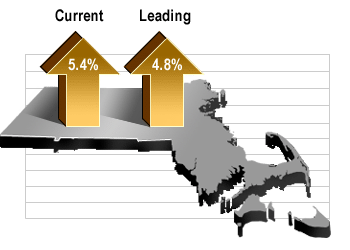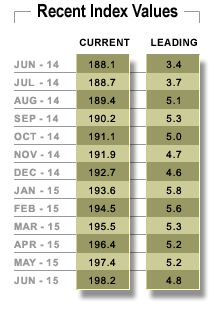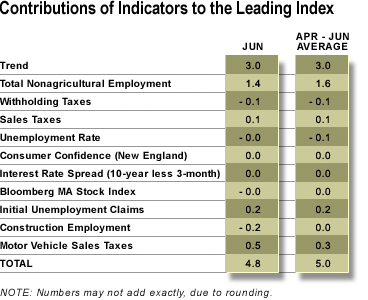State economy expands robustly in Q2, UMass journal reports
State economy expands robustly in Q2, UMass journal reports Strong job and spending growth cause for optimism, international threats remain.
June 2015
 Massachusetts real gross domestic product grew at an estimated annual rate of 5.4 percent, in the second quarter of 2015 according to the MassBenchmarks Current Economic Index, released today by MassBenchmarks, the journal of the Massachusetts economy published by the UMass Donahue Institute in collaboration with the Federal Reserve Bank of Boston. U.S. real gross domestic product grew at an annual rate of 2.3 percent according to the advance estimate of the U.S. Bureau of Economic Analysis. Based on the latest available information, we now estimate that in the first quarter of 2015, the state economy expanded at a 2.1 percent annualized rate while the nation grew at a 0.6 percent annualized rate.
Massachusetts real gross domestic product grew at an estimated annual rate of 5.4 percent, in the second quarter of 2015 according to the MassBenchmarks Current Economic Index, released today by MassBenchmarks, the journal of the Massachusetts economy published by the UMass Donahue Institute in collaboration with the Federal Reserve Bank of Boston. U.S. real gross domestic product grew at an annual rate of 2.3 percent according to the advance estimate of the U.S. Bureau of Economic Analysis. Based on the latest available information, we now estimate that in the first quarter of 2015, the state economy expanded at a 2.1 percent annualized rate while the nation grew at a 0.6 percent annualized rate.
In the second quarter, the state's economy rebounded strongly from the weather-induced slowdown of the first quarter, with robust growth in employment and spending. Massachusetts payroll employment expanded at a 3.1 percent annual rate in the second quarter, nearly twice as fast as in the first quarter when employment grew at a 1.7 percent annualized rate. Nationally, payroll employment grew at a 1.7 annual rate in the second quarter, down from 2.2 percent in the first quarter. The state's unemployment rate fell from 4.8 percent in March to 4.6 percent in June, while the U.S. unemployment rate fell from 5.5 percent to 5.3 percent during the same period. The state's unemployment rate has reached pre-recession levels.
 "The rising tide appears to finally be lifting the boats of the long-term unemployed, even though conditions for these workers remain difficult", noted Alan Clayton-Matthews, MassBenchmarks Senior Contributing Editor and Associate Professor of Economics and Public Policy at Northeastern University, who compiles and analyzes the Current and Leading Indexes. The broader U-6 measure of unemployment – which includes part-time workers who want full-time work and those who are unemployed but marginally attached to the labor force declined significantly in the second quarter. "For the 12-month period ending in June, the Massachusetts U-6 rate fell to 10.4 percent, a 0.6 percentage point drop from the 12-month period ending in March. In June, Current Population Survey-based estimates put the Massachusetts U-6 rate at 9.7 percent. The corresponding U.S. rate in June was 10.5 percent," Clayton-Matthews added.
"The rising tide appears to finally be lifting the boats of the long-term unemployed, even though conditions for these workers remain difficult", noted Alan Clayton-Matthews, MassBenchmarks Senior Contributing Editor and Associate Professor of Economics and Public Policy at Northeastern University, who compiles and analyzes the Current and Leading Indexes. The broader U-6 measure of unemployment – which includes part-time workers who want full-time work and those who are unemployed but marginally attached to the labor force declined significantly in the second quarter. "For the 12-month period ending in June, the Massachusetts U-6 rate fell to 10.4 percent, a 0.6 percentage point drop from the 12-month period ending in March. In June, Current Population Survey-based estimates put the Massachusetts U-6 rate at 9.7 percent. The corresponding U.S. rate in June was 10.5 percent," Clayton-Matthews added.
Massachusetts income and spending growth was also very strong in the second quarter. Based on withholding tax revenues, we estimate that state wage and salary income in the second quarter grew at a 4.8 percent annual rate, following growth of 4.8 percent in the first quarter. Consumer and business spending on goods subject to the state's regular sales and motor vehicle sales tax increased dramatically in the aftermath of the snowiest winter on record. In the second quarter, spending grew at a whopping 19.3 percent annual rate, following 1.8 percent growth in the first quarter. The ability and willingness of households and businesses to spend reflects the underlying strength of the state economy and bodes well for future growth.
The MassBenchmarks Leading Economic Index for June is 4.8 percent, and the three-month average for April through June is 5.0 percent. The leading index is a forecast of the growth in the current index over the next six months, expressed at an annual rate. Thus, it indicates that the economy is expected to grow at an annualized rate of 4.8 percent over the next six months (through December 2015), suggesting that the state's solid economic performance will continue through the rest of the year. It is projecting real state gross product growth of 5.1 percent in the third quarter and 4.8 percent in the fourth quarter.
But while the state economy appears to be in the midst of a solid economic expansion that positions the Commonwealth for solid future growth, risks to the outlook remain. Weak international economic conditions and geopolitical uncertainty continue to weigh heavily on the economic outlook for the Commonwealth and the nation. The strong dollar combined with sluggish growth in Europe and slowing growth in China has had a significant impact on state and national exports. For the first five months of this year, Massachusetts merchandise exports are down 14.0 percent as compared to the first five months of 2014, while U.S. merchandise exports are down 5.2 percent during the same period of time.
 The 10 indicators that comprise the leading index usually do not all move in tandem. Typically, some may indicate an expectation of faster than average growth, while at the same time others may indicate an expectation of slower than average growth. The following table accounts for the contributions of each towards faster or slower growth than the trend of 3.0 percent. The index value is their sum.
The 10 indicators that comprise the leading index usually do not all move in tandem. Typically, some may indicate an expectation of faster than average growth, while at the same time others may indicate an expectation of slower than average growth. The following table accounts for the contributions of each towards faster or slower growth than the trend of 3.0 percent. The index value is their sum.
In June, four indicators contributed to a forecast of above-trend growth: total nonagricultural employment, sales taxes, initial unemployment claims, and motor vehicle sales taxes. Four indicators contributed to average-trend growth: the unemployment rate, consumer confidence, the interest rate spread between 10-year and 3-month U.S. Treasury securities, and the Bloomberg stock index for Massachusetts. Two indicators contributed to below-trend growth: withholding taxes, and construction employment.
In the three-month period April through June, four indicators contributed to a forecast of above-trend growth: total nonagricultural employment, sales taxes, initial unemployment claims, and motor vehicle sales taxes. Four indicators contributed to average-trend growth: consumer confidence, the interest rate spread between 10-year and 3-month U.S. Treasury securities, the Bloomberg stock index for Massachusetts, and construction employment. Two indicators contributed to below-trend growth: withholding taxes, and the unemployment rate.
The current and historical quarterly estimates for state domestic product growth include adjustments for changes in productivity growth. These adjustments are estimates of the quarterly deviations from trend in the growth of the ratio of output to employment and output to wage and salary income. In the second quarter of 2015, these adjustments subtracted 0.5 percentage points from the annual rate of growth. In the first quarter, these adjustments subtracted 3.5 percentage points from the annual rate of growth. For the forecast of state domestic product growth in the second and third quarters of this year, productivity growth is assumed to return to its trend.
Several recent months of the indices are revised each release. These revisions are a result of the statistical method used to create the index, as well as revisions in the underlying indicators.
--------
All of the indicators except interest rates refer to Massachusetts. The current index is composed of four indicators: nonagricultural employment, withholding taxes, sales taxes, and the unemployment rate. The leading index includes these four current indicators plus the other six (leading) indicators in the contributions table. All of the indicators are as of June, except for interest rates and the Bloomberg stock index for Massachusetts, which are through July 24. The MassInsight Consumer Confidence Index is released every third month. Intervening months are interpolated, and changes in the Conference Board's Consumer Confidence Index for the U.S. are used to extrapolate to the current month of the index, as needed. Series measured in current dollars or values, i.e., withholding taxes, sales taxes, the Bloomberg stock index, and motor vehicle sales taxes, are deflated by the U.S. consumer price index for all urban consumers, excluding food and energy.
For a description of the methodology used to construct these indices, see: Alan Clayton-Matthews and James H. Stock, "An application of the Stock/Watson index methodology to the Massachusetts economy," Journal of Economic and Social Measurement, vol. 25 (1998/1999), pp. 183-233.
Dr. Alan Clayton-Matthews
MassBenchmarks
Northeastern University, School of Public Policy and Urban Affairs
July 30, 2015

